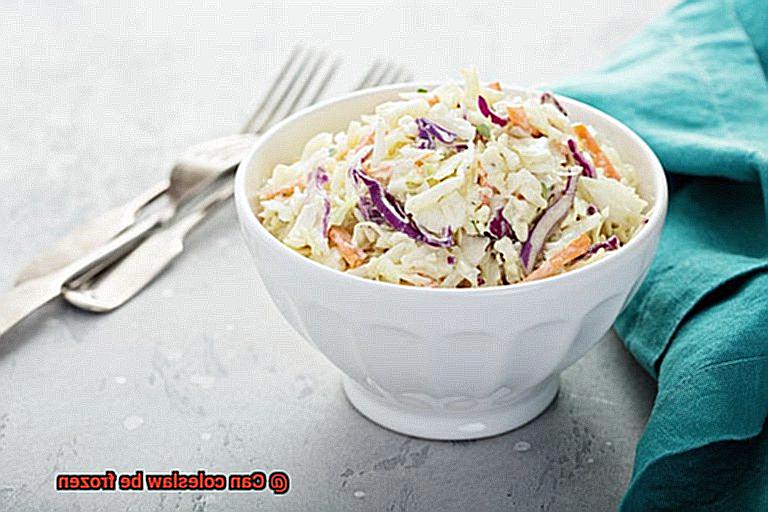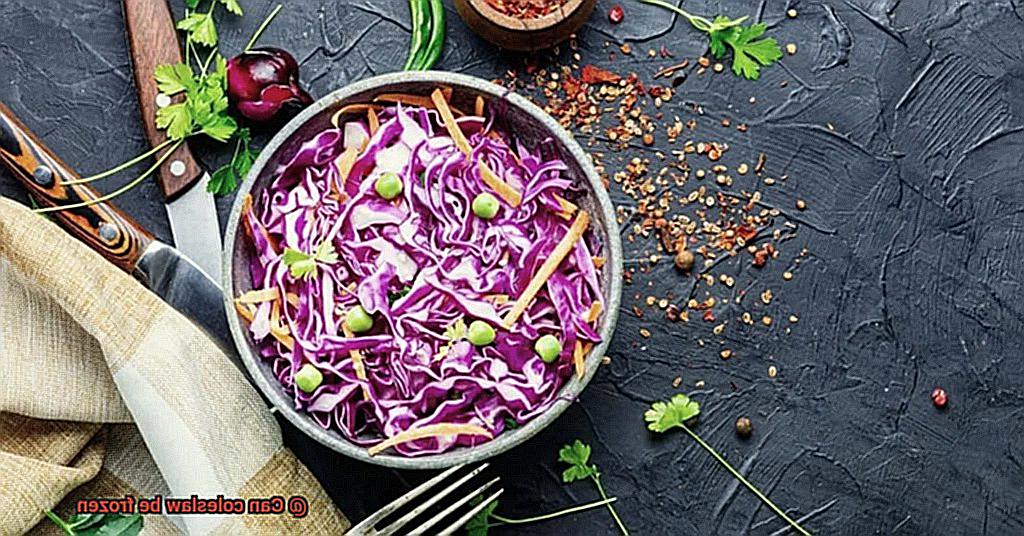Do you ever find yourself with a bowl of leftover coleslaw that ends up being thrown away? Or maybe you’re hosting a big shindig and want to prep your coleslaw ahead of time. Whatever the reason, you’re not alone in wondering if coleslaw can be frozen. The good news is that it absolutely can. But before you toss your slaw into the freezer, there are some things you should keep in mind.
In this blog post, we’ll dive deep into the question “Can coleslaw be frozen?” We’ll explore the pros and cons of freezing your favorite cabbage-based dish, as well as the best ways to do so. From proper storage techniques to thawing methods, we’ve got all the tips and tricks to ensure your coleslaw stays fresh and delicious.
So whether you’re a die-hard coleslaw fan looking to avoid waste or a party planner trying to stay ahead of the game, this post has everything you need to know about freezing coleslaw. So grab a fork and let’s dig in.
Contents
What is Coleslaw?
Coleslaw is a beloved, classic side dish that has been enjoyed for centuries by people all over the world. It’s a refreshing salad made with shredded cabbage, carrots, and a dressing that can be creamy or vinegar-based, giving it a delicious range of flavors. This versatile dish is easy to make and can be customized with different vegetables and dressings to suit your taste preferences.
The origins of coleslaw can be traced back to the Dutch word “koolsla,” which means “cabbage salad.” Dutch immigrants brought this dish to the United States in the 1700s, and it has since become a staple in American cuisine. In addition to cabbage and carrots, other common ingredients in coleslaw include red onion, bell peppers, apples, and raisins.
If you’re a fan of coleslaw and looking to keep some on hand for later, you may be wondering if it can be frozen. While freezing coleslaw is possible, it’s important to note that the texture and taste may be affected. When coleslaw is frozen, the water in the vegetables expands and can cause them to become mushy when thawed. Additionally, the dressing may separate and become watery.
To freeze coleslaw properly, start by preparing it as you normally would. Once mixed together, transfer it to an airtight container or freezer-safe plastic bag. Be sure to remove any excess air from the container or bag before sealing it shut. Label the container with the date of preparation and place it in the freezer.
When you’re ready to use the frozen coleslaw, remove it from the freezer and let it thaw in the refrigerator overnight. Resist the urge to speed up the thawing process by using hot water or a microwave as this can make the vegetables even mushier. Once thawed, give it a good stir to re-incorporate any separated dressing.

Can Coleslaw Be Frozen?
The good news is that you can freeze coleslaw. However, it’s important to keep in mind that freezing coleslaw may compromise the quality of the dish. As an expert on this topic, I’m here to share with you some tips on how to freeze coleslaw for the best results.
When it comes to freezing coleslaw, the secret is all in the dressing. It’s recommended to use a recipe without any dairy products such as milk or sour cream. These ingredients do not freeze well and can cause the dressing to separate and become grainy when thawed. Instead, opt for recipes with vinegar-based or oil-based dressings that will hold up better in the freezer.
Once you’ve chosen your recipe, it’s time to prepare your coleslaw for freezing. To prevent freezer burn and moisture buildup, store your coleslaw in an airtight container or freezer bag. Make sure to remove as much air as possible before sealing. Label the container with the date of freezing so you can keep track of how long it’s been stored.
When it’s time to thaw your frozen coleslaw, be patient. Place it in the refrigerator overnight and avoid thawing at room temperature as this can cause bacterial growth. Once thawed, give your coleslaw a good stir and drain off any excess liquid before serving.
While freezing coleslaw may not produce the same texture and flavor as fresh, following these tips can help ensure that your frozen coleslaw is still enjoyable as a side dish or used as an ingredient in a recipe.
In summary, here are the main points to remember when freezing coleslaw:
- Choose a recipe without dairy products
- Store in an airtight container or freezer bag
- Label with date of freezing
- Thaw in the refrigerator overnight
- Give it a good stir and drain excess liquid before serving
How to Prepare Coleslaw for Freezing
There are a few things you should keep in mind to ensure the best flavor and texture. Here are five sub-sections to guide you through the process:
Choose Fresh Vegetables
Fresh and high-quality vegetables are key to preparing coleslaw for freezing. You can use a variety of vegetables, such as cabbage, carrots, bell peppers, onions, and celery. It’s important to select fresh vegetables that are free from any blemishes or bruises.
Shred the Vegetables
Before freezing, shred or chop the vegetables into small, uniform pieces. This helps them freeze more quickly and evenly. You can use a food processor or box grater to shred the vegetables, or simply chop them by hand.
Mix the Dressing
Mix your desired dressing for the coleslaw, ensuring that it coats all the vegetables evenly. It’s best to stick with vinegar or oil-based dressings as they tend to freeze better than mayonnaise-based dressings.
Portion and Seal
Divide the coleslaw into small, airtight containers or freezer bags. Removing as much air as possible before sealing prevents freezer burn and keeps the coleslaw fresh. A vacuum sealer is an excellent tool to achieve this.
Label and Freeze
Label each container with the date of preparation and any other pertinent information like type of dressing used. Store in the freezer for up to three months.
When it’s time to eat your frozen coleslaw, thaw it in the refrigerator overnight and give it a good stir before serving. This ensures that all the flavors are well-mixed.
Effects of Freezing on Coleslaw
While convenience may be a priority, it’s essential to know the effects of freezing on coleslaw. As an expert in this field, let me share with you my findings on the subject.
Coleslaw is a cold, crunchy side dish made with shredded cabbage, carrots, and mayonnaise dressing. However, when vegetables freeze, the water inside the cells expands and causes damage to the cell walls, resulting in limp and mushy vegetables once thawed. Unfortunately, this is especially true for cabbage, which is the primary ingredient in coleslaw. The mayonnaise dressing also tends to separate and become watery when frozen, affecting the dish’s overall taste and texture.
But don’t worry; there are ways to mitigate these unwanted effects. One option is to freeze the vegetables separately from the dressing. This way, you can thaw and mix them together just before serving. Another option is to use a vinegar-based dressing instead of mayonnaise since it holds up better when frozen.
To ensure that your frozen coleslaw still tastes great, follow these tips: select fresh vegetables, shred them evenly, mix the dressing well, portion and seal in airtight containers or bags, label with preparation date and type of dressing used, and freeze for up to three months.
Thawing Frozen Coleslaw
Freezing coleslaw can be a great solution, but it does come with some challenges. The texture and taste of coleslaw can change when it is frozen and then thawed. Don’t worry, though, because there are ways to thaw frozen coleslaw that will help preserve its texture and flavor.
The key to successfully thawing frozen coleslaw is to do it slowly and gently. Resist the temptation to rush the process by using a microwave or hot water. Instead, transfer the frozen coleslaw from the freezer to the refrigerator and allow it to thaw overnight. This may require some patience, but trust us, the end result will be worth it.
Once the coleslaw has thawed completely, give it a good stir to redistribute any excess moisture that may have accumulated during the thawing process. If the coleslaw seems too watery, you can drain off some of the excess liquid before serving.
It’s important to note that once coleslaw has been thawed, it should be consumed within a few days. Freezing can alter the texture and flavor of coleslaw over time, making it less fresh-tasting.
To summarize:
- To thaw frozen coleslaw, transfer it from the freezer to the refrigerator and allow it to thaw slowly overnight.
- Once thawed, stir the coleslaw and drain off any excess liquid if necessary.
- Consume thawed coleslaw within a few days for best results.
Tips for Best Results When Freezing Coleslaw
Coleslaw is a delightful side dish that’s perfect for any summer barbecue or gathering. However, sometimes we end up with more coleslaw than we can eat, and freezing it can be a great way to save it for later consumption. But how do you achieve the best results when freezing coleslaw? Here are some tips to keep in mind:
Use Fresh Ingredients
The quality of your coleslaw largely depends on the freshness of your ingredients. Using fresh cabbage, carrots, and other vegetables will ensure that your coleslaw maintains its texture and flavor during the freezing process.
Opt for the Right Dressing
Mayonnaise-based dressings tend to separate and become watery when frozen, which can ruin the texture of your coleslaw. Instead, go for vinegar-based dressings or dressings made with sour cream or yogurt. These dressings will help maintain the texture and flavor of your coleslaw when frozen.
Consider Portion Sizes
Smaller portions tend to freeze more quickly and evenly than larger ones. To make it easier to defrost only the amount you need at any given time, consider dividing your coleslaw into smaller containers or bags before freezing.
Proper Labeling
It’s essential to properly label your frozen coleslaw with the date of preparation and any other relevant information such as the type of dressing used. This will make it easier to keep track of how long your coleslaw has been in the freezer and ensure that you consume it before its quality deteriorates.
Thawing Your Coleslaw
When you’re ready to use your frozen coleslaw, thaw it in the refrigerator overnight instead of at room temperature. This will help prevent bacterial growth and ensure that your coleslaw stays safe to eat.
Revitalize Your Coleslaw
Once thawed, give your coleslaw a good stir to redistribute any dressing that may have separated during freezing. You may also want to add a bit of fresh dressing or other seasonings to help revive the flavors. Keep in mind that frozen coleslaw will likely have a softer texture than fresh coleslaw, so don’t expect it to be exactly the same.
Alternatives to Freezing Coleslaw
Fear not. There are alternative methods to preserve your coleslaw that will maintain its crisp texture and extend its shelf life.
The first option is to store your coleslaw in an airtight container in the refrigerator. This method can keep your coleslaw fresh for a few days, but be sure to consume it before it starts to wilt or become slimy. No one wants slimy coleslaw.
Another effective method is to make a vinegar-based coleslaw dressing. The acid in the vinegar acts as a natural preservative, which helps ward off bacteria and keeps your coleslaw fresh for longer. To make the dressing, mix apple cider vinegar, sugar, salt, pepper, and a touch of olive oil. Toss this dressing with your coleslaw ingredients and store it in an airtight container in the refrigerator for up to 5 days.
For those who are always on-the-go, packing individual portions of your coleslaw in mason jars is an excellent option. Layer the ingredients starting with the dressing at the bottom, followed by shredded cabbage, carrots, and any other desired add-ins. Keep the jar upright and pack it with an ice pack to keep it cool until you’re ready to dig in.
e25INnxZ880″ >
Conclusion
In summary, coleslaw can indeed be frozen, but it’s crucial to bear in mind that the texture and flavor may be impacted. When frozen, the water content in the vegetables expands, leading to a mushy consistency once defrosted. Additionally, the dressing may separate and become watery. However, with proper freezing techniques, you can ensure your coleslaw remains fresh and scrumptious.
To freeze coleslaw effectively, select a recipe without dairy products like milk or sour cream since these ingredients don’t fare well in the freezer. Instead, opt for vinegar-based or oil-based dressings. Store your coleslaw in an airtight container or freezer-safe plastic bag, eliminate any excess air from the container or bag before sealing it shut, label it with the date of preparation, and put it in the freezer.
When you’re ready to use your frozen coleslaw, allow it to thaw gradually in the refrigerator overnight. Avoid hastening the thawing process by using hot water or a microwave as this can make the vegetables even softer. Once defrosted, give it a good stir to re-incorporate any separated dressing.
If you prefer preserving your coleslaw without freezing it, store it in an airtight container inside your refrigerator for several days. Alternatively, whip up a vinegar-based dressing that acts as a natural preservative and keeps your coleslaw fresh for longer periods.






